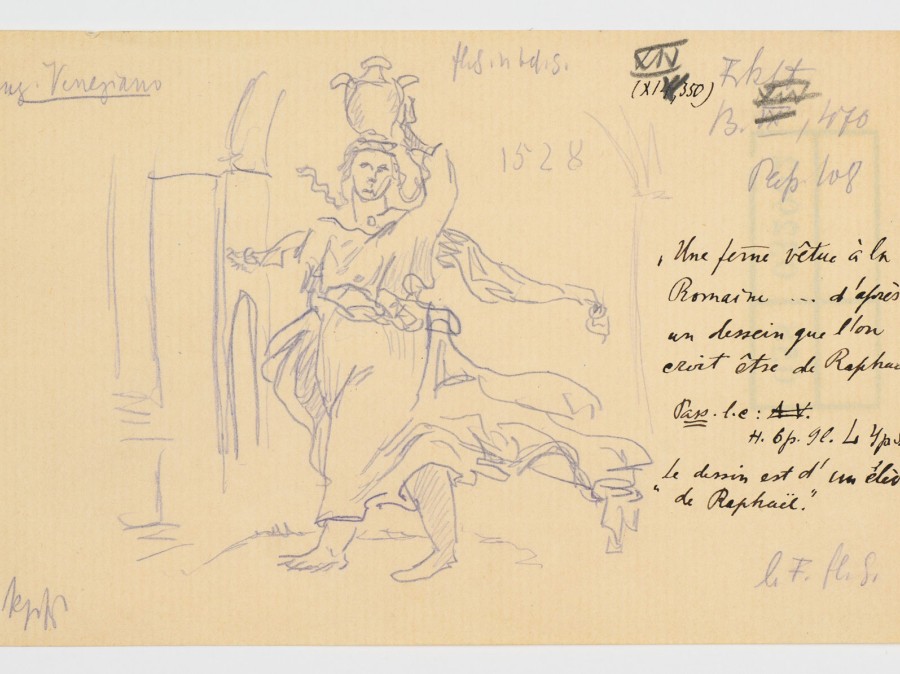Aby Warburg’s Ninfa: Leitmotif, Transformation, Afterlife, Reception

Aby Warburg, Notes relating to an engraving by Agostino Veneziano (after Raphael or Giulio Romano), 1528, taken from: Jean David Passavant, Le Peintre-Graveur, vol. 6, Leipzig: Rudolph Weigel, 1864, p. 62 (Nr. 108).
The female figure in motion, dressed in loose garments all’antica, is seen as the prototypical incarnation of Aby Warburg’s concept of the Pathosformel. As a leitmotif from his doctoral dissertation on Botticelli to the Bilderatlas Mnemosyne the figure/figuration has attracted much attention in Warburg scholarship and beyond. Based on Warburg’s Nachlass, Dr. Wedepohl shall revisit this leitmotif and re-evaluate the role of the so-called Ninfa fiorentina in Warburg’s thought. Specific attention will be given to the wider context of the exchange of two fictional letters titled “Ninfa Fiorentina”, the only known outcome of Warburg’s soon aborted collaboration with the Dutch poet and critic André Jolles. The letters are witness to the genesis of Warburg’s ideas concerning the patronages of two influential bankers from the circle of Lorenzo de’ Medici, Francesco Sassetti and Giovanni Tornabuoni who commissioned the famous Birth of St John in Santa Maria Novella featuring the most iconic example of the “Florentine” nymph. Dr. Wedepohl shall use this and other examples to demonstrate how Warburg’s wanted to present this figure – oscillating between psychophysical and psychohistorical parameters – as a link between text and image.
Dr. Claudia Wedepohl has studied Art History and Italian Literature at the Universities of Göttingen and Hamburg. She joined the staff of the Warburg Institute in 2000. Since 2006 she is the Institute’s Head Archivist. Claudia has held fellowships at the Zentrum für Literatur- und Kulturforschung in Berlin and the Research Centre Morphomata at the University of Cologne. Her academic work focusses on fifteenth-century Italian art and architecture, and art historiography around 1900. She has published widely on the genesis of Aby Warburg’s ideas and key terms. Her current project relates to the genesis of Warburg’s Bilderatlas. Claudia is co-editor of Warburg’s “Gesammelte Schriften” series (De Gruyter, Berlin) and responsible for the volume “Kleine Schriften und Vorträge”. Among her publications are: In den glänzenden Reichen des ewigen Himmels. Cappella del Perdono und Tempietto delle Muse im Herzogpalast von Urbino, München: Scaneg 2009, The Muses and Their Afterlife in Post-Classical Europe, ed. by Kathleen W. Christian, Clare E.L. Guest and Claudia Wedepohl (Warburg Institute Colloquia Series, 26), London: The Warburg Institute and Turin: Nino Aragno Editore 2014, Warburg, Cassirer und Einstein im Gespräch. Kepler als Schlüssel der Moderne, Berlin: Wagenbach 2015 (co-author Horst Bredekamp) and Aby Warburg 150. Work, Legacy, Promise, ed. by David Freedberg and Claudia Wedepohl, Berlin: De Gruyter 2024 (forthcoming).




